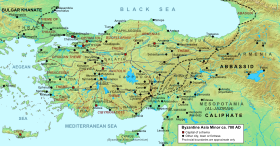Abbasid invasion of Asia Minor (782)
| Abbasid invasion of Asia Minor (782) | |||||||
|---|---|---|---|---|---|---|---|
| Part of the Arab–Byzantine Wars | |||||||
 Map of Byzantine Asia Minor and the Byzantine-Arab frontier region ca. 780 |
|||||||
|
|||||||
| Belligerents | |||||||
| Abbasid Caliphate | Byzantine Empire | ||||||
| Commanders and leaders | |||||||
|
Harun al-Rashid al-Rabi' ibn Yunus al-Barmaki |
Empress Irene Staurakios Michael Lachanodrakon Tatzates Anthony the Domestic |
||||||
| Strength | |||||||
| 95,793 (al-Tabari) | unknown | ||||||
| Casualties and losses | |||||||
| unknown | 56,090 (al-Tabari) | ||||||
The Abbasid invasion of Asia Minor in 782 was one of the largest operations launched by the Abbasid Caliphate against the Byzantine Empire. The invasion was launched as a display of Abbasid military might in the aftermath of a series of Byzantine successes. Commanded by the Abbasid heir-apparent, the future Harun al-Rashid, the Abbasid army reached as far as Chrysopolis, across the Bosporus from the Byzantine capital, Constantinople, while secondary forces raided western Asia Minor and defeated the Byzantine forces there. As Harun did not intend to assault Constantinople and lacked ships to do so, he turned back.
The Byzantines, who in the meantime had neutralized the detachment left to secure the Abbasid army's rear in Phrygia, were able to trap Harun's army between their own converging forces. The defection of the Armenian general Tatzates, however, allowed Harun to regain the upper hand. The Abbasid prince sent for a truce and detained the high-ranking Byzantine envoys, who included Empress Irene's chief minister, Staurakios. This forced Irene to agree to a three-year truce and pay a heavy annual tribute. Irene then focused her attention to the Balkans, but warfare with the Arabs resumed in 786, until mounting Arab pressure led to another truce in 798, on terms similar to those of 782.
Taking advantage of the internal difficulties of the Umayyad Caliphate that resulted from the civil wars of the 740s and the subsequent Abbasid Revolution, the Byzantines under Emperor Constantine V (reigned 741–775) were able to regain the initiative on their eastern borders from the Arabs, and pursued an aggressive strategy. With the gradual consolidation of the Abbasid regime in the 760s and 770s, the situation became more balanced: the Arabs resumed their large-scale raids deep into Asia Minor, although the Byzantines were still capable of major counterstrikes. Thus in 778, the Byzantines, under Michael Lachanodrakon, seized the town of Germanikeia (Ma'rash), where they captured significant amounts of booty and took many Syrian Christians captive, and defeated an army sent against them by the Abbasid general Thumama ibn al-Walid. In the next year, the Byzantines took and razed the fortress city of Hadath, forcing Caliph al-Mahdi (r. 775–785) to replace the rather passive Thumama with the veteran al-Hasan ibn Qahtaba. Hasan led over 30,000 troops in an invasion of Byzantine territory, but the Byzantines offered no opposition and withdrew to well-fortified towns and refuges, until a lack of supplies forced Hasan to return home without achieving much.
...
Wikipedia
